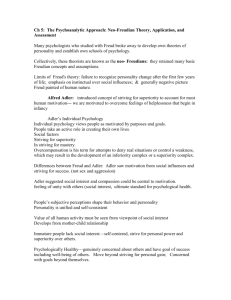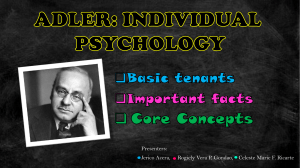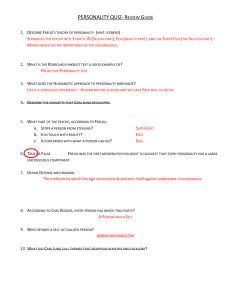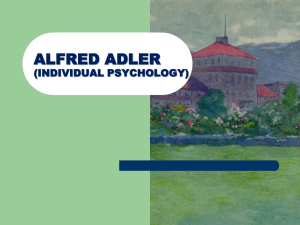Ch 5: The Psychoanalytic Approach Neo
advertisement
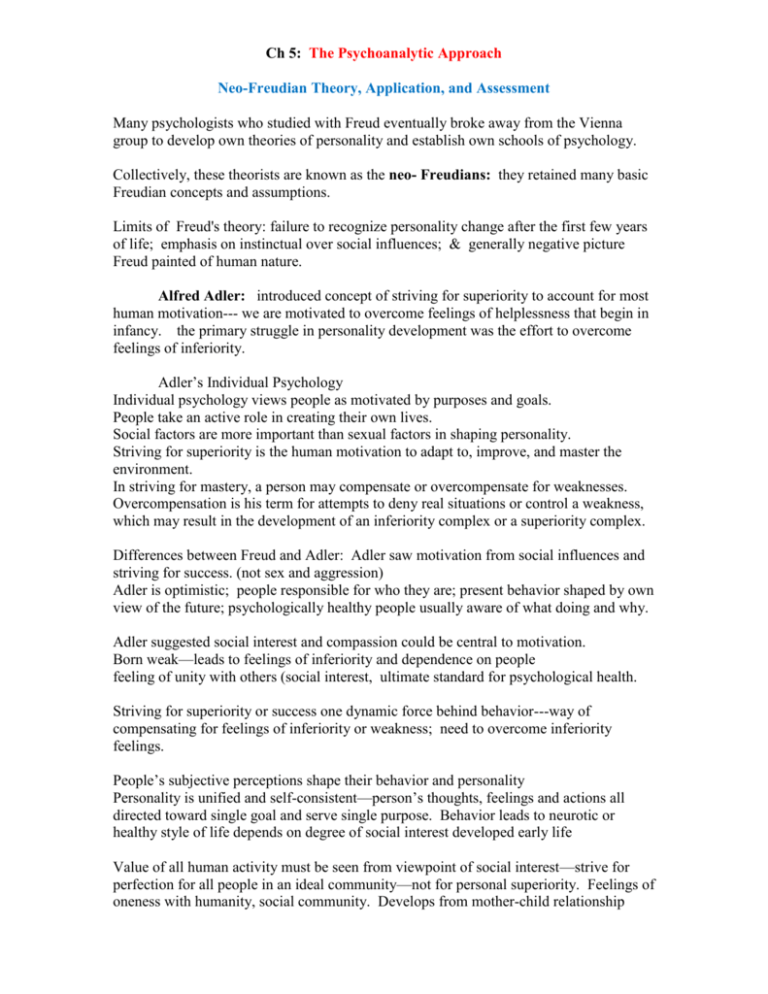
Ch 5: The Psychoanalytic Approach Neo-Freudian Theory, Application, and Assessment Many psychologists who studied with Freud eventually broke away from the Vienna group to develop own theories of personality and establish own schools of psychology. Collectively, these theorists are known as the neo- Freudians: they retained many basic Freudian concepts and assumptions. Limits of Freud's theory: failure to recognize personality change after the first few years of life; emphasis on instinctual over social influences; & generally negative picture Freud painted of human nature. Alfred Adler: introduced concept of striving for superiority to account for most human motivation--- we are motivated to overcome feelings of helplessness that begin in infancy. the primary struggle in personality development was the effort to overcome feelings of inferiority. Adler’s Individual Psychology Individual psychology views people as motivated by purposes and goals. People take an active role in creating their own lives. Social factors are more important than sexual factors in shaping personality. Striving for superiority is the human motivation to adapt to, improve, and master the environment. In striving for mastery, a person may compensate or overcompensate for weaknesses. Overcompensation is his term for attempts to deny real situations or control a weakness, which may result in the development of an inferiority complex or a superiority complex. Differences between Freud and Adler: Adler saw motivation from social influences and striving for success. (not sex and aggression) Adler is optimistic; people responsible for who they are; present behavior shaped by own view of the future; psychologically healthy people usually aware of what doing and why. Adler suggested social interest and compassion could be central to motivation. Born weak—leads to feelings of inferiority and dependence on people feeling of unity with others (social interest, ultimate standard for psychological health. Striving for superiority or success one dynamic force behind behavior---way of compensating for feelings of inferiority or weakness; need to overcome inferiority feelings. People’s subjective perceptions shape their behavior and personality Personality is unified and self-consistent—person’s thoughts, feelings and actions all directed toward single goal and serve single purpose. Behavior leads to neurotic or healthy style of life depends on degree of social interest developed early life Value of all human activity must be seen from viewpoint of social interest—strive for perfection for all people in an ideal community—not for personal superiority. Feelings of oneness with humanity, social community. Develops from mother-child relationship Immature people lack social interest—self-centered, strive for personal power and superiority over others. Psychologically Healthy—genuinely concerned about others and have goal of success including well-being of others. Move beyond striving for personal gain; Concerned with goals beyond themselves. The self-consistent personality structure develops into a person’s style of life—flavor of life—goals, self concept, attitude toward the world. Express social interest through action. creative power, freedom to create own style of life, in control of own life Adler identified parental pampering and neglect as two sources of later personality problems. Birth order--- argued that middle born children were the most achieving and were less likely to experience psychological disorders than were first-borns or last-borns. Carl Jung’s Analytical Psychology Carl Jung contributed the concepts of introversion, extroversion, personal unconscious, and collective unconscious to the study of personality. Jung stated that the roots of personality go back to the dawn of human existence and are contained in a collective unconscious. Jung proposed the existence of a collective unconscious that houses primordial images he called archetypes. The collective unconscious contains material each of us inherited from past generations and is basically the same for all people. Among the most important of the archetypes are the anima, the animus, and the shadow. Jung pointed to the recurrent surfacing of archetypal symbols in folklore, art, dreams, and psychotic patients as evidence for their existence. Erik Erikson: Ego Psychology Ego performs constructive function---as opposed to Freud’s mediator function Goals of ego—establish identity; satisfy need for mastery over environment. Powerful and independent part of personality. Identity: complex inner state includes sense of individuality, uniqueness and continuity with past and present. Term from Erikson—identity crisis—confusion and despair from lacking sense of identity. Uncertain about who you are, your values, lacking direction. Erikson outlined eight stages of personality development that we pass through during our lifetimes. At each stage we are faced with a crisis and two means to resolve the crisis. Ego helps adapt to various conflicts and crises of life. Stages are an interaction of opposites—people have harmonious and disruptive experiences. Conflict or clash between elements produces a basic ego strength. Too little basic strength at one stage results in core pathology (lack hope from infancy— withdrawal) Ego identity shaped by multiplicity of conflicts and events—past, present and anticipated Identity crisis—characterized personality development from adolescence on. Not catastrophic event—but opportunity for either adaptive or maladaptive adjustment 8 Stages in lifespan Karen Horney --- anxious insecurity stems from inadequate childrearing experiences are the source of all personality conflicts. The need for security is a prime motive in human existence Freud’s views of women bothered her---instead cultural and social factors responsible for differences between gender—not biology. emphasized the importance of sociocultural factors in personality development. Person’s reaction to real or imagined dangers or threats—termed anxiety—stronger motivating force than sexual drive or libido. Neurotic people—trapped in a selfdefeating lifestyle. Neurotic trends or strategies used to cope with emotional problems. Individuals cope with anxiety using three interaction styles or strategies Moving toward people—compliant type, submission. Helpless, dependent. Attach selves to whomever is available—any relationship better than loneliness and feeling unwanted. Moving against people—aggressive type of personality; aggression and hostility compensation for feelings of insecurity and inadequacy. Take advantage of others in adulthood. Externalization (like projection) so respond to others as if others will take advantage of them. Moving away from people---detached type. Tune out the world, instead of interacting with others. Desire privacy and self-sufficiency, avoid affection, love and friendship. Avoid anxiety by avoiding involvement. Womb envy—men’s envy of women’s ability to bear and nurse children. (Freud’s ideas of penis envy). Each gender has attributes that the other admires, and men compensate for inability to have kids through achievement. Freud was highly critical of organized religion, calling it wish fulfillment and a type of neurosis. Jung explained humankind's persistent need for religion in terms of a God archetype. modern psychotherapists take the place of religious leaders when patients become disenchanted with the answers provided by their religion. Well known neo-Freudian personality assessment instruments is the Myers-Briggs Type Indicator. Test measures psychological types, as outlined by Jung. Test scores divide people into types along four dimensions: extraversion-introversion, sensing-intuitive, thinking-feeling, and judgment-perception. Researchers have challenged the way the test divides people into categories. Strengths of the neo-Freudian theories in contributions made to psychoanalytic theory. Corrected some of the limitations they found in Freud's work, many theorists introduced important concepts to the field of psychology, influencing many later approaches to personality. Criticisms of the neo- Freudians include use of biased and questionable data to support the theories. In addition, critics have charged that some of the theories are oversimplified and incomplete.
